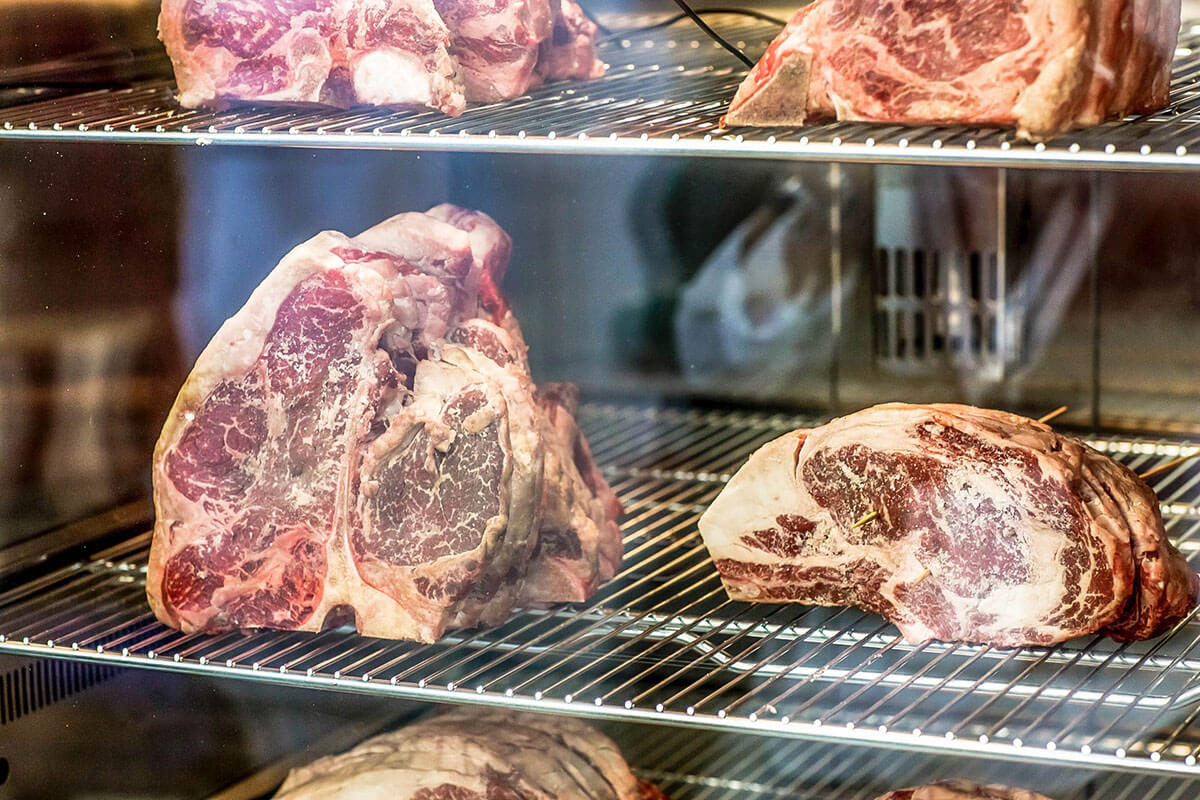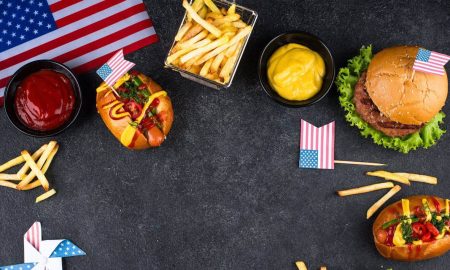Technically, we’re talking about controlled decomposition here, but aging sounds better on a menu. There’s a lot more science behind it than you might suspect at first bite. Join us on a little journey into the depths of the aging cabinet and find out why meat plus mold can equal delicious.
Good things come to those who wait
There are several ways of taking meat to the next level. Just as the name suggests, aging refines and tenderizes meat over time. Rome wasn’t built in a day, after all. Meat is tough right after the animal is slaughtered; aging helps turn it into something you’d want on your plate. Although “aged beef” has only become a trendy phrase in recent years, the tradition of hanging beef, pork, or wild game for several days or weeks goes back centuries. Over the past couple of decades, though, people have developed the time-honored process of controlled aging into a science all its own. Basically, muscle tissue contains natural enzymes that break it down gradually, and aging means giving those enzymes time to do their thing. As they work, they transform meat from rough ‘n tough to soft ‘n tender. Dry aging, incidentally, can also “age” the fat in the meat, turning it rancid, so fattier meats like Wagyu are usually wet-aged to keep them from smelling and tasting like week-old French fries.
The time is ripe
Some people swear by dry aging, others prefer vacuum aging, and still others like to come up with their own methods. The latter group includes people like Dirk Ludwig, who invented ash aging (where the meat ages in beechwood ashes, giving it a smoky flavor) and aqua aging (submerging the meat in mineral water for four weeks until it reaches peak maturity). Of course, there’s more to “aqua aging” than just cracking open a bunch of Perrier and pouring it into a bathtub of filet mignon— Ludwig’s process uses a special container that ensures just the right proportions of water, meat, minerals, and carbon dioxide at all times. The meat comes out tender and juicy, with a mild mineral-y taste. “I got this crazy idea of putting meat in mineral water because I wasn’t satisfied with the results I got from wet aging in vacuum bags,” explains Ludwig, the fourth-generation owner and operator of Der Ludwig, a butcher shop in Schlüchtern. “Wet aging results in really juicy meat, but the lactic acid bacteria give it a slight sour taste that I don’t like.”
Let’s take a little scientific detour, shall we? The natural aging process begins right after the animal is slaughtered, as the energy stored in the muscle tissue (a carbohydrate called glycogen) starts breaking down, creating lactic acid. If you vacuum-pack freshly slaughtered meat, the lactic acid can go right on working. That’s not at all dangerous, but it may mean the meat smells and tastes a little sour when you first take it out of the bag. “Vacuum-packed meat should be refrigerated, open and dry, for another three to four days after being unsealed,” says Frank Albers, a meat wholesaler who works with producers around the world. Doing that gets rid of the lactic acid and the sour note it creates. Dry aging means storing the meat dry (who’d have guessed?), so lactic acid bacteria never have a chance to grow. “That’s another reason dry aging has gotten so popular in recent years,” Ludwig notes. But wet aging has advantages over dry, too. Vacuum packed meat requires less space to store and transport, and the meat doesn’t dry out, so it loses less weight. Dry aging can reduce the amount of liquid in the meat by up to 10 percent, plus the dry outer layer has to be trimmed off—another loss of up to 15 percent. “If the meat is aged on the bone,” Albers says, “you don’t have to trim quite as much, because the area around the bone doesn’t dry out.”

Dried meat. Beef steak. / Image: Fotolia / davit85
But why dry age anything if it’s going to get 25 percent smaller? Because it’s awesome, obviously! Dry aging gives the meat a wonderfully complex, nutty flavor that makes up for the loss a million times over. That doesn’t change the fact that it’s a tricky, time-consuming process, though, which is why dry-aged meat is so pricey. What about Dirk Ludwig and his aqua aging, then?
Lactic acid makes meat sour, and carbon dioxide is carbonic acid, so… doesn’t that make it worse? “We use acids like vinegar to marinate meat, which tenderizes it and keeps it juicy,” Ludwig explains. “So that’s where I got the idea to use carbonation in the same way, as a kind of natural acidic marinade.” Many, many soggy experiments later, Ludwig finally managed to perfect the method. Pork, lamb, and beef are all delicious aqua aged; these days, Ludwig usually gives ribeyes and round steak the CO2 treatment at his butcher shop.
Ten years ago, another mad scientist type started wondering whether, since people like blue cheese, maybe they’d like…well, blue meat, so to speak. Microbiologist Lucas Oechslin and his longtime friend Marco Tessaro decided the idea was so crazy that it just might work, so they founded Luma Delicatessen together, built a 20-square-foot aging cabinet, and started tinkering. Nowadays, they sell about 40 tons of Luma beef every year, along with nearly 80 tons of other meaty delicacies. Their path to success was a bumpy one, lined with countless tests using different molds—not to mention a lot of doubtful looks from other people. But once you’ve tried the results, you’ll understand why they never gave up. For a naturally occurring edible mold to be approved for use in the food industry, it has to be carefully monitored and grown under highly controlled conditions; otherwise, there’d be no guarantee that only one particular variety of fungus was being used in its purest form. Precisely regulated temperatures and air humidity are the cornerstones to successful aging.
Luma puts its meat in a cooling chamber, so the mold can penetrate the meat uniformly. Each piece stays in there for between three and eight weeks, depending on size and consistency. Over time, a white coating of mold (the “fruiting body”) grows over the meat until it covers the entire surface. Besides changing the taste of the meat, the enzymes in the fungus break down the rigor mortis and the collagen that make the meat tough. Once it reaches perfect maturity, the meat is flash frozen and sold; it has a freezer life of up to two years. After thawing, it needs to be used within one to two weeks, so that the taste doesn’t change. They use their edible mold on pork, too.
“Aged pork has a less intense flavor than aged beef,” Oechslin says. “It has notes of fois gras, macadamia, and cognac. More palatable to the masses. Luma beef, on the other hand, is earthy, mushroomy, cheesy, nutty, with a sort of cured-ham aroma… It’s for real meat freaks.” The pork loin only spends about five weeks aging, while the sirloin takes around seven. The meat ages under conditions similar to the ones used in dry aging—except for the mold, obviously.
Aging gracefully
So we should just age all of our meat, is that it? Not exactly. Even though aging doesn’t actually start until the animal is slaughtered, quality plays a huge role in determining which meat to use the process on. First of all, not all types of meat get better with age. Rabbit, pork belly or butt, and shoulder of lamb can all be really tasty without aging (though they need to be rubbed with salt quickly to prevent rigor mortis from setting in). Of course, you’re probably only likely to get totally un-aged meat by slaughtering the animal yourself, unless it’s immediately flash frozen—travel distances between slaughterhouses and meat processing plants are too long to avoid it otherwise.
Poultry generally doesn’t age well at all. It needs a day or two for the enzymes to break down the collagen, just like with all meat, but you’re not going to find any chickens hanging out for weeks in an aging cabinet. Why not, you ask? It’s mainly a question of size. More specifically, about the amount of water the meat contains. In all of the methods we discussed here (except wet aging, of course), the water in the meat evaporates over time. “Pork fillets look like shoelaces after they’ve been hung for a couple of weeks,” Albers grins. With large cuts of meat, this method of refinement is really worth the wait. And once you take that first magical bite of perfectly aged pork, beef, veal, or goat, you’ll probably forget about all the science behind the process anyway.















